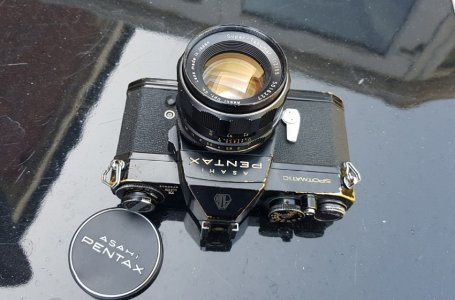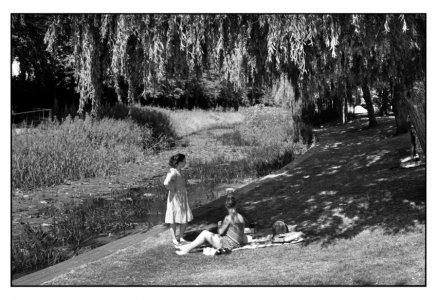The Spotmatic's original battery, marked V400PX was 1.35v Mercury same as the PX625, banned for environmental reasons. But the Spotmatic doesn't require an exact 1.35v as it has a "bridge" circuit and will work fine with the 1.55v Alkaline and 1.6v Silver cells. S625PX 1.55vI only wish the Spotmatics used a more easily obtainable battery. I know about the Wein replacement, but hearing aid batteries aren't really that viable for me. (I may get one, just to figure out what watch battery can fit instead!) The 394 battery is a good option but you have to look around for it, but you need to use a proper spacer, which I have, fortunately.
AAlfano
Well-known
That's why I like my SL. Also, if you're buying a meterless camera, no worries about potential corrosion in the battery compartment.I only wish the Spotmatics used a more easily obtainable battery. I know about the Wein replacement, but hearing aid batteries aren't really that viable for me. (I may get one, just to figure out what watch battery can fit instead!) The 394 battery is a good option but you have to look around for it, but you need to use a proper spacer, which I have, fortunately.
titrisol
Bottom Feeder
While there is a lot of nitpicking about the spotmatic and the silver-ox batteries, a lot of experienced users (Spotmatic UserGroup) have shown beyond doubt that without adjustment 394s (AG-9) and 392/384 work fine. They last a long time (2-4yrs) so having a spare is not that hard.I only wish the Spotmatics used a more easily obtainable battery. I know about the Wein replacement, but hearing aid batteries aren't really that viable for me. (I may get one, just to figure out what watch battery can fit instead!) The 394 battery is a good option but you have to look around for it, but you need to use a proper spacer, which I have, fortunately.
I've got a few SPotties over the years and alwaysu the main prblem is opening the battery compartment.
Vinegar (overnight) works in most cases, sometimes PB-Blaster and heat treatments are needed. After that apply some vaseline or anti-seize to allow the next person to open it easily.
Zuiko-logist
Well-known
I thought the 50/1.4 was radioactive.
AAlfano
Well-known
It is (the seven element versions), as are several other Takumars, including—going off memory—the 35mm f/2, the 55mm f/1.8, and some versions of the 85mm f/1.8 and f/1.9 lenses.I thought the 50/1.4 was radioactive.
titrisol
Bottom Feeder
Yes, from Takumar - Camera-wiki.org - The free camera encyclopedia
Asahi used Thorium oxide in the production of optical glass in several Super-Takumar, Super-Multi-Coated, and even in a few SMC-Takumars between 1964 and 1973. In these lenses usually only one element of this glass was used, either in front or in the back. The drawback is that thoriated glass tends to discolor over time, to a yellow-brown color which can be reversed by the action of photons (bright light) and UV light.[18] The discoloration also reduces the brightness of the lens, to the point that it might lose 1/2 to 3/2 stops. Many users have proven that exposing the yellowed lenses to sunlight for a few days, UV light or even a bright LED light will clear the lens element.
Notable lenses that have this kind of glass are: Super- and Super-Multi-Coated Takumar 50mm f/1.4 (7 element version), 20mm f/4.5, 35mm f/2, 55mm f/1.8, 55mm f/2 and 85mm f/1.8. Super Takumar 6x7 105mm f/2.4.
Fortunately most of the residual radiation is Alpha-type and is not dangerous and will not fog the film.[2] Studies carried out by the US Army show that glass attenuates alpha radiation and any residual will be absorbed in a surface layer of less than 100 micrometers. [19]
Asahi used Thorium oxide in the production of optical glass in several Super-Takumar, Super-Multi-Coated, and even in a few SMC-Takumars between 1964 and 1973. In these lenses usually only one element of this glass was used, either in front or in the back. The drawback is that thoriated glass tends to discolor over time, to a yellow-brown color which can be reversed by the action of photons (bright light) and UV light.[18] The discoloration also reduces the brightness of the lens, to the point that it might lose 1/2 to 3/2 stops. Many users have proven that exposing the yellowed lenses to sunlight for a few days, UV light or even a bright LED light will clear the lens element.
Notable lenses that have this kind of glass are: Super- and Super-Multi-Coated Takumar 50mm f/1.4 (7 element version), 20mm f/4.5, 35mm f/2, 55mm f/1.8, 55mm f/2 and 85mm f/1.8. Super Takumar 6x7 105mm f/2.4.
Fortunately most of the residual radiation is Alpha-type and is not dangerous and will not fog the film.[2] Studies carried out by the US Army show that glass attenuates alpha radiation and any residual will be absorbed in a surface layer of less than 100 micrometers. [19]
KoNickon
Nick Merritt
The 625 (and for that matter 675/357) will not fit the battery compartment of the Spotmatic. The Spotmatic F, yes -- that will accept the 625s.The Spotmatic's original battery, marked V400PX was 1.35v Mercury same as the PX625, banned for environmental reasons. But the Spotmatic doesn't require an exact 1.35v as it has a "bridge" circuit and will work fine with the 1.55v Alkaline and 1.6v Silver cells. S625PX 1.55v
Last edited:
Zuiko-logist
Well-known
Thank you!Yes, from Takumar - Camera-wiki.org - The free camera encyclopedia
Asahi used Thorium oxide in the production of optical glass in several Super-Takumar, Super-Multi-Coated, and even in a few SMC-Takumars between 1964 and 1973. In these lenses usually only one element of this glass was used, either in front or in the back. The drawback is that thoriated glass tends to discolor over time, to a yellow-brown color which can be reversed by the action of photons (bright light) and UV light.[18] The discoloration also reduces the brightness of the lens, to the point that it might lose 1/2 to 3/2 stops. Many users have proven that exposing the yellowed lenses to sunlight for a few days, UV light or even a bright LED light will clear the lens element.
Notable lenses that have this kind of glass are: Super- and Super-Multi-Coated Takumar 50mm f/1.4 (7 element version), 20mm f/4.5, 35mm f/2, 55mm f/1.8, 55mm f/2 and 85mm f/1.8. Super Takumar 6x7 105mm f/2.4.
Fortunately most of the residual radiation is Alpha-type and is not dangerous and will not fog the film.[2] Studies carried out by the US Army show that glass attenuates alpha radiation and any residual will be absorbed in a surface layer of less than 100 micrometers. [19]
KoNickon
Nick Merritt
The battery compartment cover is definitely a shortcoming of these cameras -- shallow coin groove so that if there's some corrosion, you can really mangle the slot in trying to get it open. And so many of them have bubbling of the chrome finish, which indicates there has been some battery leakage.While there is a lot of nitpicking about the spotmatic and the silver-ox batteries, a lot of experienced users (Spotmatic UserGroup) have shown beyond doubt that without adjustment 394s (AG-9) and 392/384 work fine. They last a long time (2-4yrs) so having a spare is not that hard.
I've got a few SPotties over the years and alwaysu the main prblem is opening the battery compartment.
Vinegar (overnight) works in most cases, sometimes PB-Blaster and heat treatments are needed. After that apply some vaseline or anti-seize to allow the next person to open it easily.
xayraa33
rangefinder user and fancier
KoNickon
Nick Merritt
In my experience, the solar UV rays take a loong time to work. I have a 50/1.4 ST "basking" at the moment, but I've found with Nikkors and Rokkors this takes months.
xayraa33
rangefinder user and fancier
Leaving a lens exposed to the sun can melt the helical lube and it migrates to the aperture leaves, causing sticky diaphragm blades in auto stop down lenses necessitating pro servicing the lens.In my experience, the solar UV rays take a loong time to work. I have a 50/1.4 ST "basking" at the moment, but I've found with Nikkors and Rokkors this takes months.
Pál_K
Cameras. I has it.
No. It is negligible. More to worry if you eat lots of bananas, fly on planes frequently, or live in a brick house.Is anyone health concerned with the radio activity of the SMC 55mm f1.8 lenses ?
Don‘t eat the glass part of the lens and you’ll be fine.
See this chart:
KoNickon
Nick Merritt
Right -- I keep mine inside, in a sunny place (avoiding too much direct sun). So that may help explain why the process takes so long.Leaving a lens exposed to the sun can melt the helical lube and it migrates to the aperture leaves, causing sticky diaphragm blades in auto stop down lenses necessitating pro servicing the lens.
hap
Well-known
NoIs anyone health concerned with the radio activity of the SMC 55mm f1.8 lenses ?
p.giannakis
Pan Giannakis
The main issues with the production of hot lenses revolved around health and safety issues with staff working in these facilities and safe disposal of old lenses.
Has anyone ever heard of thoriated eyepieces though? I am pretty sure I've read about it but I can't remember if they were put on cameras or microscopes.
Has anyone ever heard of thoriated eyepieces though? I am pretty sure I've read about it but I can't remember if they were put on cameras or microscopes.
xayraa33
rangefinder user and fancier
titrisol
Bottom Feeder
An IKEA LED lamp does the job as well... I was skeptical until I tried it.In my experience, the solar UV rays take a loong time to work. I have a 50/1.4 ST "basking" at the moment, but I've found with Nikkors and Rokkors this takes months.
PS the radiactivity is negligible, it was investigated in the 50s when the Aero-Ektars were first introduced.
p.giannakis
Pan Giannakis
pixie79
Member
The Pentax Spotmatic can use other battery. It only needs to fit. It has a 'bridge' circuit, so 1,35 0r 1,55 is OK. Not exact but sufficient.
The radio active was minimal! Not so with a certain 50mm f1.2! Placed in a box with a postcard paper, in dark. In a few weeks it had a black circle!
Sold it as scrap, telling buyer of my test! Finding working meter is a quest! My Leica meter cds from Metrawatt was toast in 2.5 years! The SP lasted much longer!
The radio active was minimal! Not so with a certain 50mm f1.2! Placed in a box with a postcard paper, in dark. In a few weeks it had a black circle!
Sold it as scrap, telling buyer of my test! Finding working meter is a quest! My Leica meter cds from Metrawatt was toast in 2.5 years! The SP lasted much longer!
Share:
-
This site uses cookies to help personalise content, tailor your experience and to keep you logged in if you register.
By continuing to use this site, you are consenting to our use of cookies.



